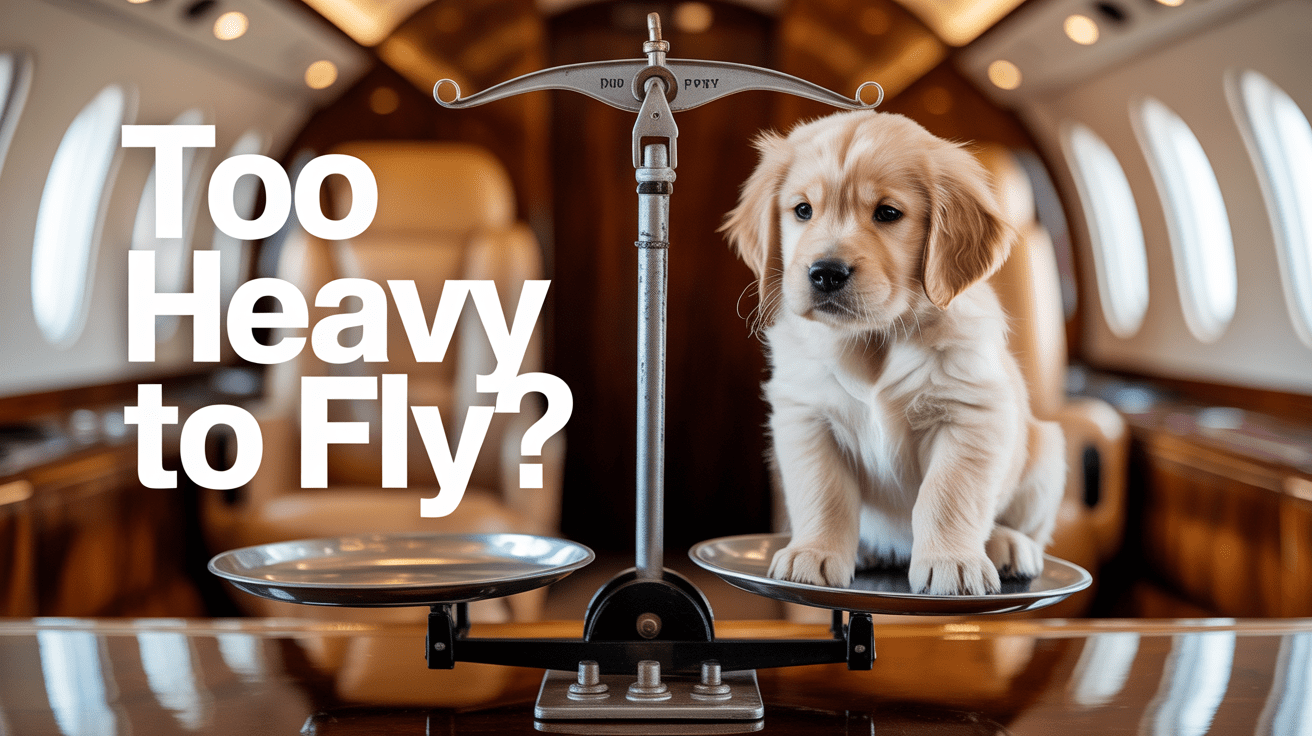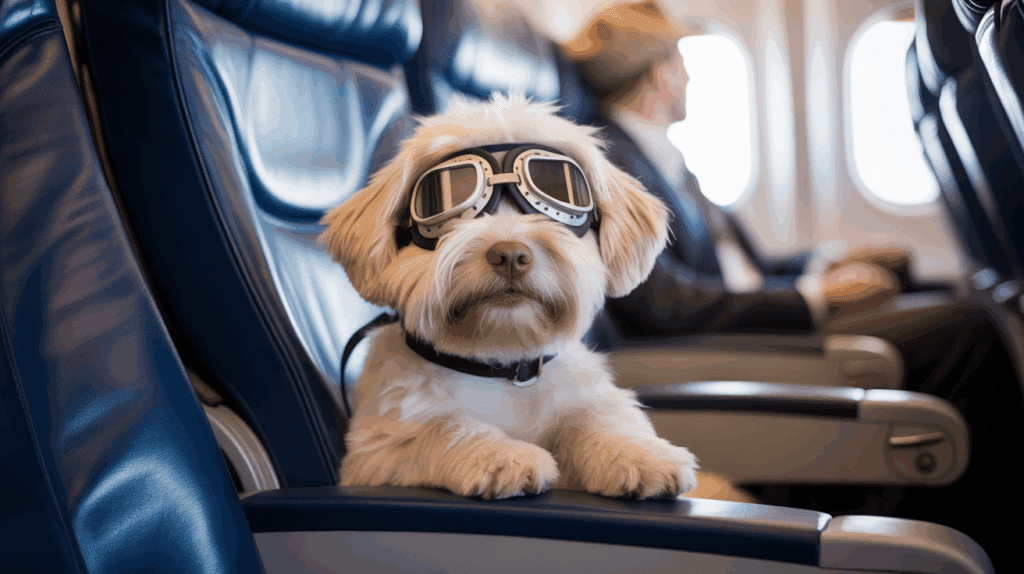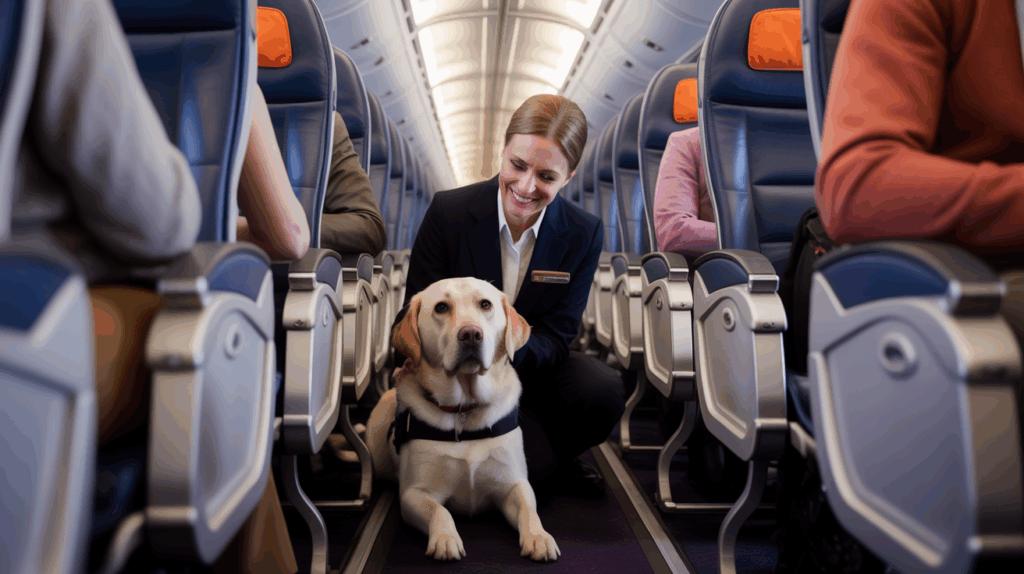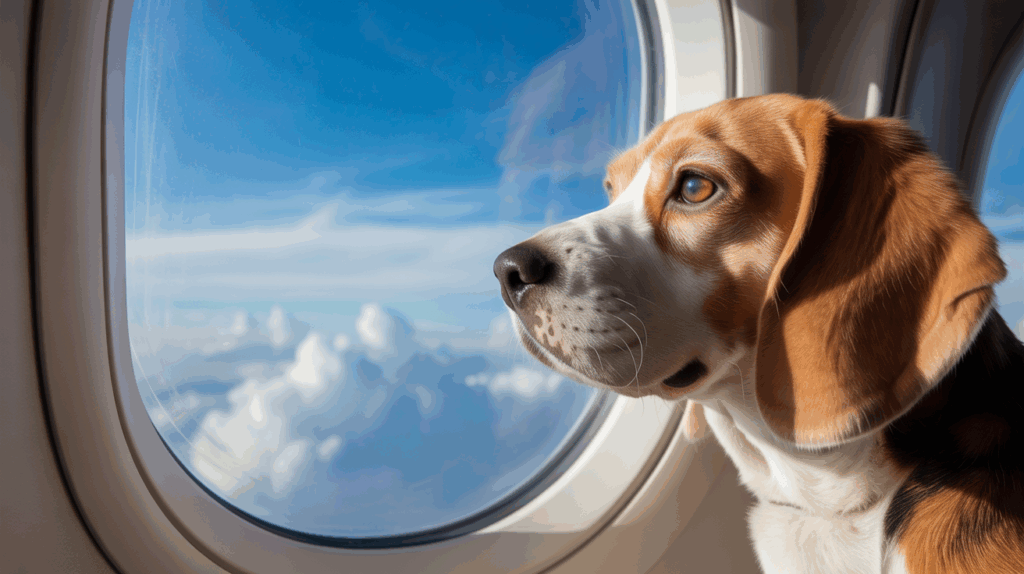
Newsletter Subscribe
Enter your email address below and subscribe to our newsletter

Enter your email address below and subscribe to our newsletter

It’s a frustrating experience. You’re on a vacation with your dog, getting ready to board the plane. But you’re denied entry because your canine friend is a few pounds over the airline’s limit. What to do now?
Many airlines follow extremely strict policies regarding the weight limits for dogs on airplanes. For example, you are likely to see a cap of 15-20 pounds for your in-cabin pet. And that weight limit includes your dog’s carrier as well.
If your dog happens to be of a larger breed, they may even need to travel as cargo. And that will often set you back about $300-$600, or even more.
Many of us think that the weight limit only applies to our dog. But that’s not the case. Most airlines take into account the weight of your pet’s carrier.
So, make sure that you weigh both your dog, along with the extra pounds of where they’ll be, to avoid getting surprised at the airport. Failure to meet the requirements will lead to denied boarding and lost fees, after all.
If you own brachycephalic breeds like pugs and bulldogs, know that there might be tighter restrictions on them. It’s mostly because of breathing risks. But if you have a service dog, know that airlines usually make exceptions to the weight rules.
Now, let’s dive into the details regarding the weight limits for dogs on airplanes. We’ll check out the hidden costs and expert-recommended preparation strategies. This could save you much stress and money. And it’s likely to ensure your canine companion’s health and safety in the air.

| Airline | In-Cabin Limit (Pet + Carrier) | Max Carrier Size (inches) | Cargo Limit (Pet + Crate) | In-Cabin Fee (2025) | Brachycephalic (Flat-Faced) Policy |
| American Airlines | 20 lbs | 19 × 11 × 11 | 100 lbs | $150 | Not allowed in cargo |
| Delta Air Lines | No general program | 18 × 11 × 11 | Service animals only | $150 (previously $95) | N/A |
| United Airlines | No limit | 18 × 11 × 11 | No cargo program* | $150 | Not allowed in cargo |
| Alaska Airlines | 20 lbs | 17 × 11 × 9.5 | 150 lbs | $100 | Restricted |
| Southwest Airlines | 20 lbs | 18.5 × 13.5 × 8.5 | No cargo program | $95 | N/A |
| JetBlue | 20 lbs | 17 × 12.5 × 8.5 | No cargo program | $125 | N/A |
| Frontier Airlines | 20 lbs | 18 × 14 × 8 | No cargo program | $75 | Restricted |

Your furry companion is definitely welcome to join you on your week-long vacation. But flying with them usually involves lots of consideration, with one of them being the weight limit. So, what’s the maximum weight for dogs on planes?
Policies across airlines can be overwhelming in that they not only differ in terms of the weight limit but also look into the type of travel (cabin vs. cargo). Even the size of your dog’s carrier must be taken into account.
First off, generally speaking, most airlines cap in-cabin pets at around 15 to 20 pounds. But make no mistake. This “20 pounds” also includes the weight of your dog’s carrier, meaning it’s the total weight of dog + carrier.
As an example, if your dog is 17 pounds, and you have a carrier that’s 4 pounds in weight, you’ve already gone over the upper limit. According to most airlines’ policies, it’s unlikely your canine friend will be allowed to board in the cabin. The practice is just that strict.
The next option is to have your dog travel as checked baggage or cargo. This means your furry friend won’t be by your side during the flight. That said, feel relieved to know that there’s usually no universal maximum weight limit for cargo transport. However, some airlines do put a restriction of 100–150 pounds (including the crate).
The difference in cost between cabin and cargo can be quite significant. You should know that in-cabin pet fees usually range from $95 to $250 per flight. But cargo costs can reach $300–$600 or more. And that range can change depending on your dog’s size and the flight distance.

It’s tempting to think: “What if I just skip mentioning that extra pound?” or “What if my carrier is a little too big?” Don’t do it. Here’s why:
Important: Gate agents use official scales and measuring tools. Their decision is final. Airline pet policies allow no exceptions.
Why do these restrictions exist in the first place? Every airline not only enforces its own rules on dog weight limits, but is also extremely strict about them. One extra pound over the limit, and you’ll likely be cancelling your trip to your sweet retreat. Let’s take a look at why these policies are important.
First, know that most airlines separate our pets into two categories. One of them is in-cabin travel, and the other one is cargo or checked baggage travel.
As you know, there’s a weight limit for your in-cabin dog that takes into account the total weight of your furry friend and their carrier. This also comes with a restriction on the carrier’s size at approximately 16–18 inches long, 10–11 inches high, and 9–11 inches wide.
The main reason for these restrictions is so that your pet can fit comfortably under the seat right in front of you with enough airflow. This is to ensure their safety (in the case of turbulence). Also, during emergencies, it’s much easier to handle carriers that are light.
Cargo or checked baggage travels are meant for your larger dog. But even if your dog is small and goes over the weight limit, they will need to travel using this option. Your (possibly) large dog needs proper ventilation and comfort. And the in-cabin route is unable to provide that. Also, it’s very difficult to restrain them in the cabin.
Again, the weight limit takes into account both your dog’s weight and that of their carrier. The size is usually around 36–48 inches long. But note that there isn’t a one-size-fits-all rule. Among other reasons, airlines enforce these restrictions to ensure your animal’s safety. And it allows the crew to handle your pet in case of an emergency.
Additionally, cargo travels usually come with more requirements. You will likely need to have a sturdy IATA-approved crate, make an advance reservation, and provide health documentation. Be ready to talk to your vet before booking cargo travel.
Remember, do not assume that all airlines follow the same standard. Some have lower limits, while others may even refuse certain breeds regardless of their weight. Aviation veterinarians say that brachycephalic breeds (like pugs or bulldogs) face additional restrictions because of their breathing problems.
Most airlines have clear rules regarding the weight limit for dogs flying in cabin and cargo. That said, there are several important exceptions that you should know of. You don’t want to be surprised, both pleasantly or otherwise, at the airport, after all.
Now, one of the biggest exceptions to these restrictions involves service dogs. Under federal and international regulations, your trained service animal does not need to follow the traditional airline weight limits. That means even your large canine friend can board with you, provided they do not block any aisles or emergency exits.
That said, you will need to provide valid documentation for your service dog. This usually includes the U.S. DOT Service Animal Air Transportation Form, a Relief Attestation Form for flights over 8 hours, and, in some cases, a recent vet health certificate. Also, if the airline determines that your dog’s breed is not safe for air travel, they can still refuse them.
Also, note that emotional support animals are no longer recognized by most U.S. airlines. You might have heard or read somewhere that these animals are under this category, but that was in the past. So, make sure not to assume your oversized dog can travel with you just because you need them. Things can turn out to be more expensive than you might think.
Another special case applies to brachycephalic (short-nosed) breeds like bulldogs and pugs. If you happen to be travelling with one, know that they are prone to respiratory stress. As a result, many airlines would restrict or even ban them from cargo travel regardless of their weight.
Vets also strongly recommend that we do not bring these breeds on flights if they do not meet the in-cabin requirements. The altitude and temperature changes can put them at serious risk. And this is only so much worse if you’re not around to take care of them personally.
Lastly, with exceptions also come costs. Now, some airlines might actually waive or reduce the fees for your service dog. But there are others that supercharge you for your oversized animal. You should expect to spend about $95-$150, minimum. This could go up to several hundred dollars if the airline needs to specially handle your dog’s accommodation.
Imagine your first flight with a fear of heights. It can be rather stressful for you. And that’s even more so for your dogs. So, you’ll need to make sure of your canine friend’s health, safety, and comfort.
Your pet might be small enough to meet the weight limit on dogs flying in cabin. But that doesn’t guarantee much if you don’t take precautions. Let’s check out how to safeguard your pet together, shall we?
Now, the first thing you need to realize is that even if your canine fits the weight limit for a dog in plane, it doesn’t mean the space is safe for them. Your companion is highly sensitive to air pressure, temperature fluctuations, and confinement. If they are short-nosed breeds, they even have a high risk of breathing issues at high altitudes.
Vet experts advise that we schedule a pre-flight check-up just to make sure that our dogs are healthy enough for travel. You might also want to give your dog up-to-date shots while you’re in the clinic. Try not to skip this step. It’s one thing to get denied while boarding, but another if something happens to your canine friend.
Comfort is about preparation in addition to the available space. Your dog will need to be in their carrier all the time during the flight. That means they won’t get to stretch much or move around for hours. This can cause anxiety (imagine the hardship of getting caged).
To curb this issue, experts recommend that we acclimate our dogs to their carriers weeks before the flight. You need to get them to feel comfortable being in there for a long time. Let them rest, play, or nap inside it at home. Place some snacks or toys in the carrier to encourage them to stay in during training. You’ll see a significant reduction in stress if your dog feels that the carrier is a safe space.
Now, if your dog is on cargo travel, that might be a lot riskier. Noise, temperature swings, and separation from you can be overwhelming for your canine friend. What you can do is to make sure the airline invests in climate-controlled cargo holds. Call ahead and ask about ventilation and temperature regulation. You should also provide something familiar (like a blanket) to keep your dog calm in their carrier.
Now, let’s take a look at what you can do to prepare your dog for their flight. If your pet is close to weight restrictions for dogs on planes, you’ll need to put in more work. Remember, airlines are very strict in upholding the weight limit policy.
The first thing you have to do is to weigh your dog and their carrier together at home. Use a household scale and do so well in advance of your trip. If the combined weight exceeds 20 pounds (usually the limit), that means your pet has gone over the max weight for dogs on planes.
If your dog is just slightly over the in-cabin weight limit (or hitting really close to it), try making some adjustments at home. Some weight management strategies include swapping calorie-dense treats for leaner options and increasing light exercise in the weeks leading up to the flight.
It’s tempting to use an oversized carrier to provide your dog with some extra room. But this might backfire. You need to make sure not to push over the max weight for dogs on the plane. And even if the weight passes, if your carrier is over the acceptable size, it’ll still get rejected. Make sure you check the guidelines and invest in something lightweight, airline-approved instead.
Finally, you want to help your dog adjust to the carrier before the trip. You can place familiar bedding or toys inside the carrier to help your dog get accustomed to being in there for long hours. This can reduce stress and make the day of travel less intimidating for them.
You may be a frequent traveler who has just started bringing your dog along with you. Or perhaps it’s just a family trip, and you don’t want your pup to miss out. In any case, you might have lots of practical questions about dog weight limits on airlines. Here are some of the most frequently asked questions for your reference to help clear your confusion.
No. Airlines do not allow you to buy a seat for your dog. If your large dog exceeds in-cabin limits, they must travel in the cargo hold in an approved crate.
In most cases, your in-cabin dog can weigh up to 15–20 pounds, including the carrier. If your dog is larger, they can go up to approximately 100–150 pounds with their crate. They’ll have to travel in cargo.
No. If your dog is 55 pounds, they have exceeded the weight limit for dogs flying in cabin. They will have to travel in the cargo hold.
Your dog can only travel in cargo in this case. You’ll need an IATA-approved crate. And you should expect to pay a fee of typically $300–$600 or more, depending on the airline.
Generally speaking, the limit is around 15–20 pounds, including the carrier. This may vary slightly between airlines. You should always verify the exact figure with your chosen airline.
Weight limits exist for safety and practicality. Your pet needs to fit securely under the seat. And larger animals need the climate control and handling of the cargo hold.
No, each airline has unique rules. Some allow slightly heavier dogs in the cabin. Others, on the other hand, may impose strict limits or ban certain breeds entirely.
You should place your dog inside the carrier and weigh them. Alternatively, if your dog moves around a lot, you can hold the carrier (with your dog inside) and step onto the scale together. Subtract your own weight afterwards. You can even weigh the carrier and dog separately, then add the totals.
In general, your service dog is exempt from standard airline weight restrictions. However, they must fit safely at your feet without blocking any aisles or exits.
Large or older dogs face higher stress during air travel. You should take your dog for a veterinary exam before the flight. Check for breathing, heart, or joint issues that could worsen in transit.
Are you getting ready to take your dog on that long-awaited journey? You should now understand that airlines set the weight limits for dogs on airplanes to help balance safety, comfort, and logistics. And you should know how to plane around them now.
If your dog is under 15–20 pounds (including the carrier), they may qualify for in-cabin travel. Otherwise, your larger pet must fly as cargo. And you should make available around $300-$600 approximately for the fees.
Weigh your canine friend with their carrier in advance and make adjustments accordingly. Check for breed-specific rules. And budget for the necessary fees. Applying all the tips learned, you should be able to board the plane with your furry companion with no problem at all.
With the right preparation, your dog’s journey will be a compliant one. And it should be safe and comfortable for both of you. Start planning now and enjoy your trip together.
Have you traveled with your dog by plane before? How was the experience? Did you run into any trouble? Let us know in the comments down below.